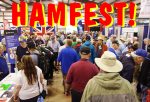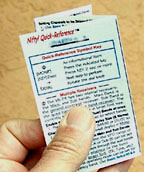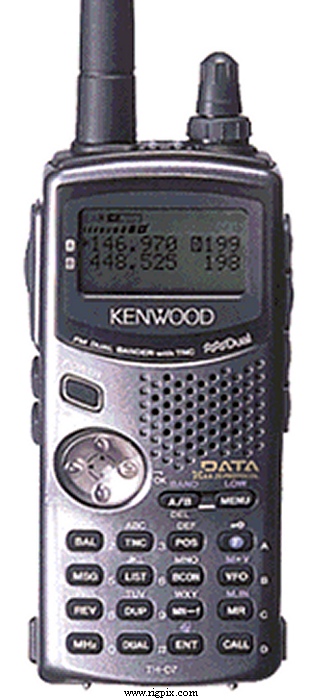
My endstate objective is to have a bicycle mobile setup with APRS and packet functionality.
Bicycle Mobile – Test #1
Objective: xmit at least one APRS beacon packet from my bicycle mobile HT to a digipeater capable of ultimately passing the packet to an Igate and enabling anyone to view my location via www.findu.com.
Components used:
(1) Garmin eTrex Vista GPS. I originally got this GPS when I was stationed in Korea back in 2001. While pulling duty in the brigade EOC I overheard radio traffic of a company XO who was making a chow run…. running hot chow out to soldiers in the field. The company XO (a lieutenant) was lost. He didn’t admit it at first, but finally said he didn’t know where he was. Being lost as a lieutenant is pretty bad, but having to admit over the brigade net that you are lost ranks among the most humiliating acts. At that point, I determined I’d purchase a GPS so I’d never be “lost”. I’ve really enjoyed the GPS so far. It worked great in Korea, I also used it in Germany, took it to Kuwait, used it on the convoy into Iraq and Baghdad, used it in and around Baghdad, and also used it on the return trip. It’s very solid and is pretty easy on the batteries. I was previously using the GPS along with my TinyTrack as an APRS beacon (http://www.livejournal.com/users/shedberg/2005/04/21/).
(2) GPS handlebar mount. I received it in the mail yesterday and installed it this morning. Pretty easy to install, the GPS slides on and locks into place.
(3) Kenwood TH-D7A(G). Designed to be used specifically for APRS, I figured the D7A was the radio for the task. I have the stock battery pack (PB-39, 9.6 V, 600mAh). For an antenna, I’m using something similar to the MFJ-1715S. It’s one of those thin, long dual band jobs.
(4) eTrex-Kenwood GPS data cable. I purchased this off of eBay from the GPSGeek store. The cable has the Garmin eTrex proprietary plug on one end and the 2.5mm plug for the radio on the other.
Pre-Test
As a preparatory test last night, I attached the D7A to my 2m/70cm vertical installed on the top of my house. I set the packet path to Wide3-3, manually inserted my lat/long location into the D7A, activated the beacon function and was able to transmit the following packets that made it to the www.findu.com database:
KD7PJQ-6>S7PS8P,WIDE3-1,qAo,N9VP:’h/Vl TH-D7A(G)
KD7PJQ-6>S7PS8P,N3XKU-15*,WIDE3,qAo,KA1UDX-1:’h/Vl TH-D7A(G)
KD7PJQ-6>S7PS8P,N4EVA-11,WIDE3*,qAo,N3IJW:’h/Vl TH-D7A(G)
KD7PJQ-6>S7PS8P,N4EVA-11,WIDE3*,qAo,W8JUK-3:’h/Vl TH-D7A(G)
KD7PJQ-6>S7PS8P,K4EME-3*,WIDE3-1,qAo,N4DSL:’h/Vl TH-D7A(G)

This test confirmed for me that the D7A was capable of transmitting APRS data locally, finding it’s way to an Igate, providing anyone the capability to check my location via the internet.
Test #1 Execution:
This morning I clipped my GPS onto my bikes handlebars and rolled the bike onto the driveway. Turning on the GPS, I was quickly able to get satellite lock and a position read out. I connected the data cable between the GPS and the D7A and powered the D7A on. A Band was already set with the APRS freq and TNC on. I pressed the POS button and the D7A successfully pulled my current location from the GPS and displayed it on the D7A. Immediately after that, the D7A’s red xmit light came on, indicating that the HT was xmiting my current position. The radio beeped and I could see other APRS traffic being received. I locked the key pad and placed the D7A into the bag on the front of my bike with the antenna sticking out at a 45 degree angle.
I headed out on my 5.44 mile trek to work.
The GPS was working fine the entire ride. The speedometer on the GPS was showing the same speed as my little Bell cycling computer.
I arrived at work and pulled the radio out of the bag. There were no stations listed on the screen – which indicates to me that no APRS stations were received by the D7A. I hit the BCON button a few times, but didn’t receive any responses.
I’m assuming one of two things happen: (1) my antenna isn’t doing an adequate job. Again, the D7A is located in the bike bag hanging off my handlebars and I’m not using any type of counterpoise with the antenna. Or (2) there was an issue with how the radio was positioned in the bag which either caused the data cable to come loose or accidentally engaged a key on the key pad.
Test assessment:
Overall the test was a failure.
Recommendations:
Before I head back home after work, I’m going to take my bike over to a location with good line-of-sight and try sending an APRS beacon to see if I’m getting a response. I’m going to first attempt to send the beacon while I’m holding the radio so I can monitor what is being displayed on the screen. If I’m successful with that, I will carefully place the radio into the bike bag and try this test again on my trip home.
 I went to the HAMBASH in Kansas City this morning. Pretty big venue, most all of the tables were filled – also some quality vendors around the periphery. Lots of old-time rigs that looked like they were in good shape. Only saw one table were there was a guy selling DVDs (that had nothing to do with ham radio). They had an XYL Lounge upstairs, with coffee and cookies. There were a few city/county EOC radio shelters setup outside but by the time I got out there, my daughter had hit the meltdown stage and so we headed back home for her nap.
I went to the HAMBASH in Kansas City this morning. Pretty big venue, most all of the tables were filled – also some quality vendors around the periphery. Lots of old-time rigs that looked like they were in good shape. Only saw one table were there was a guy selling DVDs (that had nothing to do with ham radio). They had an XYL Lounge upstairs, with coffee and cookies. There were a few city/county EOC radio shelters setup outside but by the time I got out there, my daughter had hit the meltdown stage and so we headed back home for her nap. Yesterday, the weather was great and I got a chance to take my daughter out on a bicycle ride again. Wanting to improve the TX capability of my bike-mounted TH-D7A for APRS, I built an HT Tigertail. I did notice significant improvement on my ability to get out on APRS when using the Tigertail (still with the power set at 500mW).
Yesterday, the weather was great and I got a chance to take my daughter out on a bicycle ride again. Wanting to improve the TX capability of my bike-mounted TH-D7A for APRS, I built an HT Tigertail. I did notice significant improvement on my ability to get out on APRS when using the Tigertail (still with the power set at 500mW).

 I eventually figured out how to set the tone and was on the repeater with the other folks. Then with a bit more thought and troubleshooting, I discovered my feedline connection to the rig had come loose and with that fixed I was back in business. Part of the problem is that I have a relatively new rig in the truck, the Kenwood TM-D710A. It is a very complicated rig and I have only scratched the surface on how to operate it. I was able to interface it with the Garmin Nuvi 350 thanks to a cable from
I eventually figured out how to set the tone and was on the repeater with the other folks. Then with a bit more thought and troubleshooting, I discovered my feedline connection to the rig had come loose and with that fixed I was back in business. Part of the problem is that I have a relatively new rig in the truck, the Kenwood TM-D710A. It is a very complicated rig and I have only scratched the surface on how to operate it. I was able to interface it with the Garmin Nuvi 350 thanks to a cable from 

 Farewell to Tom Mills
Farewell to Tom Mills




